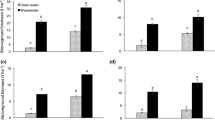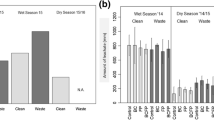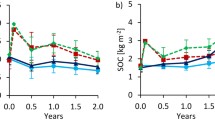Abstract
In West Africa population growth and fast urbanization challenge food security for which urban and peri-urban agriculture plays an increasing role. Adding biochar to soils depleted in soil organic carbon may improve soil quality but its effectiveness in high input systems, such as urban horticulture in West Africa, is unknown. We studied the effects of fertilization, amended biochar from agricultural waste, irrigation water quality and quantity on small-scale urban vegetable production in a multi-factorial split-plot experiment on a Haplic Lixisol in Ouagadougou, Burkina Faso. A single application of corn cob biochar at the rate of 20 t ha−1 was used in a 2-year study covering eleven cropping cycles. Biochar significantly improved total fresh matter yields of two amaranth cycles by 39% and 17%, lettuce by 7% and carrot by 11%. Repeated measures analysis showed that biochar increased average total biomass by 9% and marketable yield by 6%. Biochar was effective on fertilized plots while plant growth on unfertilized plots was limited by nutrients, most likely nitrogen (N). A 33% reduction in irrigation water caused yield declines of 4–23% which was more pronounced in fertilized plots with higher water consumption by the larger plants. Biochar increased potassium (K) concentrations while wastewater reduced phosphorus (P) in plant tissue. The study showed a positive effect of biochar on crop yields and nutrition while wastewater effects were limited to nutrient deficient plots.






Similar content being viewed by others
References
Abdou G, Ewusi-Mensah N, Nouri M, Tetteh FM, Safo EY, Abaidoo RC (2016) Nutrient release patterns of compost and its implication on crop yield under Sahelian conditions of Niger. Nutr Cycl Agroecosyst 105(2):117–128
Abdu N, Agbenin JO, Buerkert A (2011) Geochemical assessment, distribution, and dynamics of trace elements in urban agricultural soils under long-term wastewater irrigation in Kano, northern Nigeria. J Plant Nutr Soil Sci 174(3):447–458
Agegnehu G, Bass AM, Nelson PN, Muirhead B, Wright G, Bird MI (2015) Biochar and biochar-compost as soil amendments: effects on peanut yield, soil properties and greenhouse gas emissions in tropical North Queensland, Australia. Agric Ecosyst Environ 213:72–85
Agegnehu G, Bass AM, Nelson PN, Bird MI (2016) Benefits of biochar, compost and biochar-compost for soil quality, maize yield and greenhouse gas emissions in a tropical agricultural soil. Sci Total Environ 543:295–306
Ahmed HP, Schoenau JJ (2015) Effects of biochar on yield, nutrient recovery, and soil properties in a canola (Brassica napus L)-wheat (Triticum aestivum L) rotation grown under controlled environmental conditions. Bioenergy Res 8(3):1183–1196
Ahmed BO, Inoue M, Moritani S (2010) Effect of saline water irrigation and manure application on the available water content, soil salinity, and growth of wheat. Agric Water Manag 97(1):165–170
Akoto-Danso EK, Manka’abusi D, Steiner C, Werner S, Häring V, Nyarko G et al (2018) Agronomic effects of biochar and wastewater irrigation in urban crop production of Tamale, northern Ghana. Nutr Cycl Agroecosyst. https://doi.org/10.1007/s10705-018-9926-6
Alburquerque JA, Calero JM, Barrón V, Torrent José, del Campillo María, Carmen Gallardo A, Villar R (2014) Effects of biochars produced from different feedstocks on soil properties and sunflower growth. J Plant Nutr Soil Sci 177(1):16–25
Andrews SS, Karlen DL, Cambardella CA (2004) The soil management assessment framework. Soil Sci Soc Am J 68(6):1945–1962
Arif M, Ali K, Jan MT, Shah Z, Jones DL, Quilliam RS (2016) Integration of biochar with animal manure and nitrogen for improving maize yields and soil properties in calcareous semi-arid agroecosystems. Field Crop Res 195:28–35
Bargmann I, Rillig MC, Kruse A, Greef J-M, Kücke M (2014) Effects of hydrochar application on the dynamics of soluble nitrogen in soils and on plant availability. J Plant Nutr Soil Sci 177(1):48–58
Bellwood-Howard I, Häring V, Karg H, Roessler R, Schlesinger J, Shakya M (2015) Characteristics of urban and peri-urban agriculture in West Africa: results of an exploratory survey conducted in Tamale (Ghana) and Ouagadougou (Burkina Faso): IMWI working paper 163. International Water Management Institute (IMWI), Columbo, Sri Lanka
Carter S, Shackley S, Sohi S, Suy TB, Haefele S (2013) The impact of biochar application on soil properties and plant growth of pot grown lettuce (Lactuca sativa) and cabbage (Brassica chinensis). Agronomy 3(2):404–418
Chan KY, van Zwieten L, Meszaros I, Downie A, Joseph S (2008) Agronomic values of greenwaste biochar as a soil amendment. Soil Res 45(8):629–634
Cissé G, Kientga M, Ouédraogo B, Tanner M (2002) Développement du maraîchage autour des eaux de barrage à Ouagadougou: quels sont les risques sanitaires à prendre en compte? Cah agric 11(1):31–38
Climate-data (2016) https://en.climate-data.org/africa/burkina-faso/centre-285/#example0. Accessed 2016
Cornish GA, Kielen NC (2004) Wastewater irrigation—hazard or lifeline? Empirical results from Nairobi, Kenya and Kumasi, Ghana
Deenik JL, Cooney MJ (2016) The potential benefits and limitations of corn cob and sewage sludge biochars in an infertile oxisol. Sustainability 8(2):131
Diogo RVC, Buerkert A, Schlecht E (2010) Horizontal nutrient fluxes and food safety in urban and peri-urban vegetable and millet cultivation of Niamey, Niger. Nutr Cycl Agroecosyst 87(1):81–102
Enders A, Hanley K, Whitman T, Joseph S, Lehmann J (2012) Characterization of biochars to evaluate recalcitrance and agronomic performance. Bioresour Technol 114:644–653
Ercoli L, Mariotti M, Masoni A, Bonari E (1999) Effect of irrigation and nitrogen fertilization on biomass yield and efficiency of energy use in crop production of Miscanthus. Field Crop Res 63(1):3–11
Esmaili E, Kapourchal SA, Malakouti MJ, Homaee M (2008) Interactive effect of salinity and two nitrogen fertilizers on growth and composition of sorghum. Plant Soil Environ 54(12):537–546
FAO (2012) Growing greener cities in Africa: First status report on urban and peri-urban horticulture in Africa. Food and Agriculture Organization of the United Nations, Rome
Gaskin JW, Speir RA, Harris K, Das KC, Lee RD, Morris LA, Fisher DS (2010) Effect of peanut hull and pine chip biochar on soil nutrients, corn nutrient status, and yield. Agron J 102(2):623–633
George C, Kohler J, Rillig MC (2016) Biochars reduce infection rates of the root-lesion nematode Pratylenchus penetrans and associated biomass loss in carrot. Soil Biol Biochem 95:11–18
Häring V, Manka’abusi D, Akoto-Danso EK, Werner S, Atiah K, Steiner C, Lompo DJP, Adiku S, Buerkert A, Marschner B (2017) Effects of biochar, waste water irrigation and fertilization on soil properties in West African urban agriculture. Sci Rep 7(1):10738
Karam F, Mounzer O, Sarkis F, Lahoud R (2002) Yield and nitrogen recovery of lettuce under different irrigation regimes. J Appl Hortic 4(2):70–76
Kiba DI, Zongo NA, Lompo F, Jansa J, Compaore E, Sedogo PM, Frossard E (2012) The diversity of fertilization practices affects soil and crop quality in urban vegetable sites of Burkina Faso. Eur J Agron 38:12–21
Kihara J, Nziguheba G, Zingore S, Coulibaly A, Esilaba A, Kabambe V, Njoroge S, Palm C, Huising J (2016) Understanding variability in crop response to fertilizer and amendments in sub-Saharan Africa. Agric Ecosyst Environ 229:1–12
Lange B, Vejdělek ZJ (1980) Photometrische analyse. Verlag Chemie, Weinheim
Lavini A, Pulvento C, d’Andria R, Riccardi M, Jacobsen SE (2016) Effects of saline irrigation on yield and qualitative characterization of seed of an amaranth accession grown under Mediterranean conditions. J Agric Sci 154(05):858–869
Lehmann J, da Silva Jr JP, Steiner C, Nehls T, Zech W, Glaser B (2003) Nutrient availability and leaching in an archaeological Anthrosol and a Ferralsol of the Central Amazon basin: fertilizer, manure and charcoal amendments. Plant Soil 249(2):343–357
Liu Y, Lu H, Yang S, Wang Y (2016) Impacts of biochar addition on rice yield and soil properties in a cold waterlogged paddy for two crop seasons. Field Crop Res 191:161–167
Major J, Rondon M, Molina D, Riha SJ, Lehmann J (2010) Maize yield and nutrition during 4 years after biochar application to a Colombian savanna oxisol. Plant Soil 333(1–2):117–128
Nagaz K, Masmoudi MM, Mechlia NB (2012) Impacts of irrigation regimes with saline water on carrot productivity and soil salinity. J Saudi Soc Agric Sci 11(1):19–27
Nelissen V, Ruysschaert G, Manka’Abusi D, D’Hose T, de Beuf K, Al-Barri B, Cornelis W, Boeckx P (2015) Impact of a woody biochar on properties of a sandy loam soil and spring barley during a two-year field experiment. Eur J Agron 62:65–78
Novak J, Ro K, Ok YS, Sigua G, Spokas K, Uchimiya S, Bolan N (2016) Biochars multifunctional role as a novel technology in the agricultural, environmental, and industrial sectors. Chemosphere 142:1
Omami EN, Hammes PS (2006) Interactive effects of salinity and water stress on growth, leaf water relations, and gas exchange in amaranth. N Z J Crop Hortic Sci 34(1):33–44
Orsini F, Kahane R, Nono-Womdim R, Gianquinto G (2013) Urban agriculture in the developing world: a review. Agron Sustain Dev 33(4):695–720
Pan HY, Fisher KJ, Nichols MA (1999) Fruit yield and maturity characteristics of processing tomatoes in response to drip irrigation. J Veg Crop Prod 5(1):13–29
Predotova M, Gebauer J, Diogo RVC, Schlecht E, Buerkert A (2010a) Emissions of ammonia, nitrous oxide and carbon dioxide from urban gardens in Niamey, Niger. Field Crop Res 115(1):1–8
Predotova M, Schlecht E, Buerkert A (2010b) Nitrogen and carbon losses from dung storage in urban gardens of Niamey, Niger. Nutr Cycl Agroecosyst 87(1):103–114
Rajkovich S, Enders A, Hanley K, Hyland C, Zimmerman AR, Lehmann J (2012) Corn growth and nitrogen nutrition after additions of biochars with varying properties to a temperate soil. Biol Fertil Soils 48(3):271–284
Raschid-Sally L, Jayakody P (2009) Drivers and characteristics of wastewater agriculture in developing countries: results from a global assessment. International Water Management Institute (IWMI research report 127), Colombo, Sri Lanka
Sanchez CA (2000) Response of lettuce to water and nitrogen on sand and the potential for leaching of nitrate-N. HortScience 35(1):73–77
Scott CA, Faruqui NI, Raschid-Sally L (2004) Management challenges in developing countries. In: Wastewater use in irrigated agriculture: confronting the livelihood and environmental realities. CABI
Snipes M, Taylor DC (2014) Model selection and Akaike Information Criteria: An example from wine ratings and prices. Wine Econ Policy 3(1):3–9
Sou MY, Mermoud A, Yacouba H, Boivin P (2013) Impacts of irrigation with industrial treated wastewater on soil properties. Geoderma 200:31–39
Steiner C, Teixeira WG, Lehmann J, Nehls T, de Macêdo JLV, Blum WEH, Zech W (2007) Long term effects of manure, charcoal and mineral fertilization on crop production and fertility on a highly weathered Central Amazonian upland soil. Plant Soil 291(1–2):275–290
Vazquez-Montiel O, Horan NJ, Mara DD (1996) Management of domestic wastewater for reuse in irrigation. Water Sci Technol 33(10–11):355–362
Walter R, Rao BK (2015) Biochars influence sweet-potato yield and nutrient uptake in tropical Papua New Guinea. J Plant Nutr Soil Sci 178(3):393–400
Wei W, Yan Y, Cao J, Christie P, Zhang F, Fan M (2016) Effects of combined application of organic amendments and fertilizers on crop yield and soil organic matter: an integrated analysis of long-term experiments. Agric Ecosyst Environ 225:86–92
WRB IWG (2014) World Reference Base for soil resources 2014, update 2015 International soil classification system for naming soils and creating legends for soil maps. World Soil Resources (reports no. 106)
Xu G, Wei LL, Sun JN, Shao HB, Chang SX (2013) What is more important for enhancing nutrient bioavailability with biochar application into a sandy soil: direct or indirect mechanism? Eco Eng 52:119–124
Zingore S, Delve RJ, Nyamangara J, Giller KE (2008) Multiple benefits of manure: the key to maintenance of soil fertility and restoration of depleted sandy soils on African smallholder farms. Nutr Cycl Agroecosyst 80(3):267–282
Acknowledgements
This work was carried within the UrbanFoodPlus Project, funded by the German Federal Ministry of Education and Research (BMBF) and the German Federal Ministry for Economic Cooperation and Development (BMZ) under the initiative GlobE—Research for the Global Food Supply, Grant Numbers 031A242-A, 031A242-B. The support of the German Academic Exchange Service (DAAD) by a scholarship to the first author is gratefully acknowledged. We are thankful to Claudia Thiema-Fricke and Eva Wiegard at Universität Kassel, Witzenhausen for technical support. We acknowledge Dr. Kofi Atiah for producing the biochar, and also the help of our field technician Bernard Nassouri and farmers during the field work. This study would not have been possible without the infrastructural and logistic support of Institut de l’Environnement et de Recherches Agricoles (INERA), Ouagadougo, Burkina Faso.
Author information
Authors and Affiliations
Corresponding author
Electronic supplementary material
Below is the link to the electronic supplementary material.
Rights and permissions
About this article
Cite this article
Manka’abusi, D., Steiner, C., Akoto-Danso, E.K. et al. Biochar application and wastewater irrigation in urban vegetable production of Ouagadougou, Burkina Faso. Nutr Cycl Agroecosyst 115, 263–279 (2019). https://doi.org/10.1007/s10705-019-09969-0
Received:
Accepted:
Published:
Issue Date:
DOI: https://doi.org/10.1007/s10705-019-09969-0




